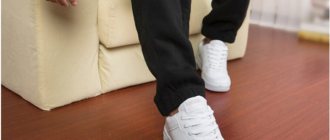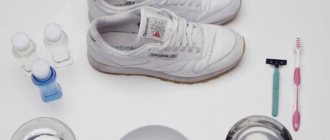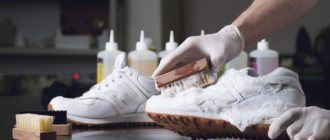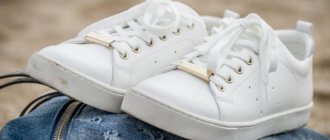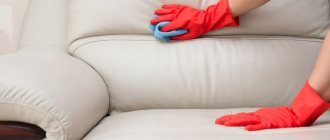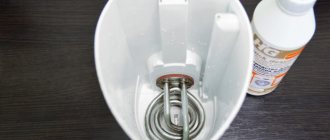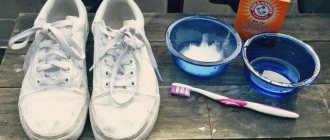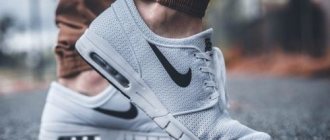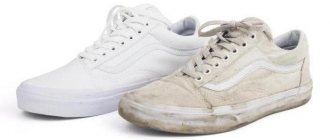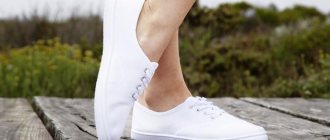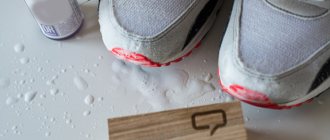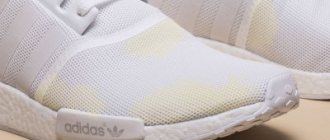Textile shoes are universal - they are worn to work, for walks, and for training. It has many advantages - soft boots practically do not rub your feet, can be easily combined with multi-colored summer clothes, and thanks to the ventilated material, your feet “breathe.” But fabric shoes quickly get dirty, and in order for the fabric model to maintain a neat appearance, it must be properly cared for.
Before moving on to care tips, a few words about how important it is to choose the size option. When buying an item, pay attention to the completeness of the product. If fabric shoes or sneakers are too wide for you, put them aside. During wear, such a product will become even wider and quickly lose its appearance. Not to mention that walking in such products is very uncomfortable. You shouldn’t buy a tight pair either - unsightly creases may form on them while walking.
After you have purchased moccasins or textile sandals, treat them with a water-repellent agent. This way they will get wet less, and your care for rag shoes will become easier. But even boots treated with a special product become deformed when wet. Therefore, you should wear fabric ballet flats and shoes only in dry weather.
Daily care for textile shoes
After each wear, sneakers should be cleaned of dirt and dust. This can be done with a dry brush with stiff bristles, and the sole can be washed from dirt with a damp cloth. For hard-to-reach places, use a small brush (or a toothbrush).
An alternative to dry cleaning is to treat the textile pair with wet wipes, which not only clean, but also help get rid of a specific unpleasant odor. To do this, just wipe the inside surface of your moccasins or sneakers with napkins. Special powders, which can be purchased at any specialized salon, help remove unwanted aroma and also prevent the formation of fungus.
After you clean the fabric pair, you need to dry it well. Dry sneakers and ballet shoes in the air, away from sunlight, fireplaces, radiators and other heating devices, otherwise the products will become deformed and become brittle from excessive dryness.
In what cases should you contact a dry cleaner?
It is not advisable to try to clean shoes with complex stains on your own . It would be safer to go straight to dry cleaning. They will do everything quickly and delicately, choosing an effective stain remover.
The service package includes not only cleaning the fabric surface, but also the soles. Deodorizing is a bonus. As a result, the shoes become like new.
Winter-type fabric sneakers should also be sent to dry cleaning so as not to unknowingly ruin the insulation.
Cleaning fabric shoes
No matter how carefully you wear an item, there comes a time when it needs more serious cleaning. How to clean rag shoes correctly?
Manual cleaning
- Gentle care involves hand washing (wash quickly, no more than 5-6 minutes, otherwise the adhesive base may not hold up).
- Shoes are removed from insoles and laces (it is faster and more effective to clean them in the washing machine with other laundry), and cleaned of dirt with a brush.
- Carefully clean the tops of shoes or ballet flats lightly moistened with water with a sponge or brush with a washing solution (washing powder, laundry soap or dishwashing liquid).
- Residues of the cleaning agent are removed, and the sandals (using a sponge) are rinsed well to avoid the formation of unsightly white stains.
- Moccasins or ballet shoes are wrung out and sent to dry in a well-ventilated area. Dry it in such a way that the water does not stagnate in the heel or toe, but flows out.
Automatic cleaning
Machine washing is not recommended:
- for shoes with sequins, rhinestones and other decorations;
- models with heels (either the heel or the drum of the washing machine may be damaged).
To find out if your shoes can be auto-cleaned, check the label. If automatic cleaning is recommended, follow these steps:
- Remove the laces and insoles and place them in a special bag (or pillowcase). Place shoes in another bag (wash light rag shoes separately from dark ones).
- Place sneakers or moccasins in the machine and select a delicate wash at +30°C. It’s great if there is a special cleaning mode.
- Use half the strength of a mild detergent.
- After finishing washing, dry the items.
No matter how appealing it is to be able to load shoes into the washing machine and take out a clean pair, you shouldn’t overuse automatic washing. Manufacturers recommend washing textile products once every 7-10 days. Otherwise, its service life will be significantly reduced.
Choosing the right mesh for your washing machine
Recommendations for choosing covers for clothes:
- If the mesh is equipped with a zipper, the tongue must be securely fixed with a special pad. Otherwise the element will damage other clothes in the drum.
- A flat envelope bag is best used for washing one item. In this case, the laundry is rinsed better.
- It is advisable to load several things into bulk bags. These nets are universal and suitable for washing jackets, curtains, and bedspreads.
- For delicate toilet parts, there are frame models. Bras, underwear with underwire, and corsets retain their shape well only in special cylindrical or spherical meshes with stiffening ribs.
- For thick items, choose cases with a zipper. For soft, stretchy fabrics, drawstring bags are suitable.
Criteria for choosing shoe covers:
- The best cover for washing shoes is a rectangular design made of mesh and semi-rigid ribs with soft seals. You can also use a clothing bag, but it will not perform all protective functions.
- One container is designed for 1 pair. The cover must match the volume of the shoe. Those with large feet should be especially careful when choosing a washing net.
- The diameter of the holes should be so small as to prevent small parts from getting into the drum and causing the laces to slip.
When purchasing any model of laundry bag, you should check its integrity, the quality of the seams, and the functionality of the locks or latches on the laces.
You can buy nets in hardware stores, large chain department stores, and sometimes they offer similar products in public laundries.
Comparison of bags from different manufacturers:
| Name | Product type | Size | Price, rub.) |
| TOP HOUSE (at Fixed Price) | Colorless fine mesh bag, designed for 3 kg of laundry, with a zipper | 50x70 cm | 280 |
| PRESS (from IKEA) | Set of 3 flat bags with zippers: 2 white for light-colored laundry, 1 black for colored and dark-colored laundry | 30x40 cm (1 piece) 40x50 cm (2 pieces) | 199 |
| Brabantia | Set of 3 white mesh zippered covers (polyester) | 33×25 cm (2 pcs.) 45×33 cm (1 pc.) | 990 |
| Brabantia | Large mesh bag (polyester) | 190x190x40 cm | 790 |
| Ginger cat | Container for washing shoes | 35x16.5x23 cm | 250 |
| Ginger cat | Assorted cylinders, frame and flat laundry bags | Medium, large, small | 54–69 |
| STORIE D'AMORE (from Faberlic) | Mesh pouch with zipper (nylon) | 40x50 cm | 199 |
| Wpro | Small case (natural material) | 25x24x15 cm | 350 |
| KONONO | Cylinder with zipper for underwear | 15x15x15 cm | 131 |
| EVA (made in Russia) | Beige woven bra container | 24x20x15 cm | 160 |
| EVE | Mesh bag (maxi size), with zipper | 47x90 cm | 159 |
Judging by the reviews, products costing less than 100 rubles, offered by small Chinese manufacturers, perform their functions just as well as more expensive bags.
Differences are found in the service life of the mesh and the quality of the fittings. Locks fail on average within 3–6 months. The seams may come apart sooner. Therefore, such products are not included in the review.
Tough stains
Traces from grass, tram rails, machine oil and other difficult-to-remove contaminants can be cleaned in different ways.
Antipyatin soap and stain remover for colored laundry will thoroughly clean sandals or shoes with prints. Light-colored shoes are cleaned, respectively, with a stain remover for light-colored fabrics. To clean oil stains at home, you can use concentrated dishwashing detergent, gasoline, or white spirit solvent.
Algorithm of actions:
- A fresh stain is intensively wiped with a cotton pad soaked in the selected substance. For severe contamination, a “compress” is effective - cotton pads soaked in gasoline or solvent are secured on both sides of the stain with clothespins.
- After some time, the dirty areas are cleaned with a brush under running water.
- The last step is washing in a machine or by hand.
How to treat sneakers from odor
Shoe odor spray To remove odor forever, it is recommended to use methods that destroy harmful microorganisms, and with it the unpleasant odor. These include:
- Special sprays for shoes. For example, you can purchase the product “Boot”, “Tulip”. Any of them will provide the desired result: the bacteria will die and the aroma will disappear. However, over time, the problem may reappear, so it is recommended to use this remedy periodically.
- Here is another way to remove odor from sneakers - this is a method of treating with a solution of potassium permanganate or formaldehyde. The inner surface of the sneakers is treated with the product. To do this you need to use a cotton swab. Then the shoes are placed in a plastic bag, after a day they are taken out and aired in the fresh air.
- Hydrogen peroxide also removes unpleasant odors and disinfects. You need to moisten a soft sponge and wipe the inner layers of the sneakers. There is no need for additional manipulations, for example, as is the case with potassium permanganate. After treatment, the shoes are aired.
- Ammonia, ethyl alcohol, vinegar. The effect will be the same as with hydrogen peroxide. These products are used to disinfect shoes; they also help prevent the smell of sweat. Use a cotton swab dipped in the solution to treat all surfaces inside the sneakers.
- Chlorhexidine. The recommended concentration of the active substance is 1%. Pharmacies offer a 0.05% product freely available. This is not enough to destroy the fungus that contributes to the appearance of a specific odor. The principle of treatment is the same as in the case of formaldehyde: the insole and internal surfaces are sprayed with the product, then the shoes are placed in a bag, hermetically sealed and left for 1-3 days.
- Miramistin 0.1%. With sneakers that smell of sweat, do exactly the same as in the previously discussed cases. You can simply treat the surfaces with a cotton swab dipped in the product. To enhance the effect, the shoes are sealed and left for several days.
- If the cause of bad odor is foot fungus, it is removed with the help of antifungal drugs: Mycostop, Gorosten. Choose a product in the form of a spray. It is used to process the inner surfaces of sneakers. You need to let the shoes dry for several hours. The procedure is repeated daily until the cause of the amber is eliminated.
- Special devices that allow treatment with ions or ultraviolet radiation. Both methods help destroy harmful microorganisms. Thanks to this, the smell will disappear, but you will have to clean the shoes once to get rid of the odor that has appeared.
White fabric shoes
Any fabric shoes require careful care, and white fabric shoes even more so. Therefore, many owners of white shoes wash them almost every day. But daily cleaning or washing leads to the fact that the pair quickly loses its appearance. Hence the conclusion - white fabric shoes are not casual. The exception is sports products. There is much less dust in gyms and fitness clubs than on the street, so light ones are a good option for training.
How to clean white rag shoes? Caring for white fabric models is not much different from caring for multi-colored fabric products. But you need to wash the white pair separately from the colored one, and use tooth powder for manual cleaning.
Do not use bleach - white fabric may turn yellow.
Velours
Velor is quite often confused with suede, however, despite the external similarity, these materials have some differences. The thick, fine pile of velor is slightly shorter than that of suede, while velor has a velvet surface only on one side, and is smooth on the inside.
Natural velor is quite capricious, so buyers often prefer more durable artificial material. Artificial velor is based on a fabric on which plant or synthetic fibers are attached.
Information. Depending on the processing technology, you can get different types of velor (fur, front, split), which are used in the production of not only shoes, but also clothing.
Immediately after purchase, velor shoes must be treated with a special protective compound at least three times, drying thoroughly after each application.
This is interesting: What to do if your sneakers are narrow and rub, how to wear them in
Velor does not tolerate high humidity, so wearing such shoes in snow or rain is not recommended.
If moisture does get onto the surface of boots or boots, it should be removed with a soft cloth.
A special brush with natural bristles can be used to clean dust from velor.
Difficult stains can be removed using a special cleaner.
Velor shoes should be dried in natural conditions without the use of heating devices. Steam will help restore the pile to its previous appearance.
When wearing velor shoes, the following rules must be observed:
- Do not wash with water;
- Do not clean without thoroughly drying first;
- Do not press on the surface of the shoe while cleaning with a brush, otherwise the pile will be damaged.
